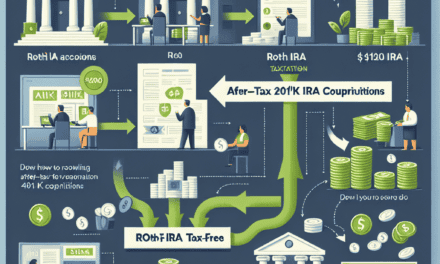“AGNC Investment: Navigating Change, Sustaining a 14% Yield Promise.”
Introduction
AGNC Investment Corp., a prominent player in the real estate investment trust (REIT) sector, is poised for a significant transformation that could have profound implications for its substantial 14% dividend yield. As a leading investor in agency mortgage-backed securities, AGNC’s strategic maneuvers and market adaptations are closely watched by investors seeking high-yield opportunities. This anticipated shift comes amid evolving economic conditions, regulatory changes, and fluctuating interest rates, all of which could impact the company’s financial performance and its ability to sustain its attractive dividend payouts. Understanding the potential outcomes of AGNC’s strategic adjustments is crucial for investors aiming to navigate the complexities of the high-yield investment landscape.
Understanding AGNC Investment’s Business Model and Its Impact on Dividend Yield
AGNC Investment Corp., a prominent player in the real estate investment trust (REIT) sector, has long been recognized for its substantial dividend yield, which currently stands at an impressive 14%. This yield is particularly attractive to income-focused investors seeking consistent returns in a low-interest-rate environment. To understand the implications of AGNC’s anticipated major shift, it is essential to delve into the company’s business model and how it influences its ability to maintain such a high dividend yield.
AGNC primarily invests in agency mortgage-backed securities (MBS), which are bonds secured by a pool of mortgage loans. These securities are backed by government-sponsored enterprises like Fannie Mae and Freddie Mac, providing a level of security and reducing credit risk. The company’s strategy involves leveraging its capital to purchase these MBS, thereby amplifying potential returns. This leverage, while enhancing yield, also introduces interest rate risk, as fluctuations in rates can significantly impact the value of the underlying securities and, consequently, the company’s profitability.
The anticipated shift in AGNC’s strategy is likely a response to the evolving macroeconomic landscape, characterized by rising interest rates and increased market volatility. As central banks around the world adjust monetary policies to combat inflation, the cost of borrowing is expected to rise. This scenario poses a challenge for AGNC, as higher interest rates can lead to a decrease in the value of its existing MBS portfolio. Moreover, the cost of leverage may increase, potentially squeezing profit margins.
In light of these challenges, AGNC may consider adjusting its investment strategy to mitigate risks and sustain its dividend yield. One potential approach could involve diversifying its portfolio by incorporating non-agency MBS or other real estate-related assets. This diversification could help reduce reliance on agency MBS and provide a buffer against interest rate fluctuations. Additionally, AGNC might explore hedging strategies to protect its portfolio from adverse rate movements, thereby stabilizing returns.
Another aspect to consider is the company’s operational efficiency. By optimizing its cost structure and enhancing asset management practices, AGNC can potentially improve its bottom line, thereby supporting its dividend payouts. Furthermore, maintaining a prudent leverage ratio will be crucial in navigating the uncertain interest rate environment. By carefully managing leverage, AGNC can balance the trade-off between risk and return, ensuring that its dividend yield remains attractive to investors.
The implications of AGNC’s strategic shift extend beyond its immediate financial performance. Investors must also consider the broader market context and how changes in AGNC’s approach might influence investor sentiment and stock valuation. A well-executed strategy that successfully adapts to the changing economic landscape could bolster investor confidence, potentially leading to a more favorable stock price performance.
In conclusion, AGNC Investment Corp.’s anticipated major shift is a strategic response to the challenges posed by rising interest rates and market volatility. By understanding the intricacies of AGNC’s business model and the factors influencing its dividend yield, investors can better assess the potential impact of these changes. As AGNC navigates this transition, its ability to maintain a high dividend yield will depend on its strategic agility, operational efficiency, and risk management practices. Ultimately, the company’s success in adapting to the evolving market conditions will determine its continued appeal to income-focused investors seeking reliable returns.
Analyzing the Factors Behind AGNC Investment’s Anticipated Major Shift
AGNC Investment Corp., a prominent player in the real estate investment trust (REIT) sector, is currently navigating a landscape marked by significant economic and market shifts. As a company primarily focused on investing in agency mortgage-backed securities, AGNC’s operations are intricately tied to the broader financial environment, particularly interest rate trends and housing market dynamics. Recently, the company has signaled an anticipated major shift, which has garnered considerable attention from investors, especially those drawn to its attractive 14% dividend yield. Understanding the factors driving this shift is crucial for stakeholders aiming to assess the sustainability of AGNC’s dividend and its future performance.
One of the primary factors influencing AGNC’s strategic adjustments is the evolving interest rate environment. The Federal Reserve’s monetary policy, particularly its stance on interest rates, plays a pivotal role in shaping the mortgage-backed securities market. In recent years, the Fed has adopted a more hawkish approach, gradually increasing interest rates to combat inflationary pressures. This shift has profound implications for AGNC, as rising rates can lead to a decrease in the value of existing mortgage-backed securities, thereby impacting the company’s asset valuations and net interest margins. Consequently, AGNC is compelled to reassess its portfolio strategy to mitigate potential adverse effects and capitalize on emerging opportunities.
In addition to interest rate considerations, the housing market’s trajectory is another critical factor influencing AGNC’s anticipated shift. The housing sector has experienced significant fluctuations, driven by factors such as supply chain disruptions, changing consumer preferences, and varying levels of housing demand. These dynamics affect the prepayment rates of mortgages, which in turn influence the performance of mortgage-backed securities. AGNC must navigate these complexities to optimize its investment strategy and ensure the stability of its income streams. By closely monitoring housing market trends, the company can make informed decisions regarding asset allocation and risk management.
Moreover, regulatory developments and government policies also play a significant role in shaping AGNC’s strategic direction. Changes in regulations governing the mortgage and housing sectors can have far-reaching implications for the company’s operations. For instance, adjustments to government-sponsored enterprise (GSE) policies or modifications in housing finance regulations can impact the availability and pricing of agency mortgage-backed securities. AGNC must remain vigilant in tracking these regulatory shifts to adapt its strategies accordingly and maintain its competitive edge in the market.
Furthermore, technological advancements and innovations in the financial sector are influencing AGNC’s operational landscape. The integration of technology in financial services has transformed how companies manage their portfolios, assess risks, and engage with investors. AGNC is likely to leverage these technological advancements to enhance its analytical capabilities, improve operational efficiency, and deliver value to its shareholders. By embracing digital tools and data-driven insights, the company can better navigate market complexities and optimize its investment decisions.
In conclusion, AGNC Investment Corp.’s anticipated major shift is driven by a confluence of factors, including interest rate trends, housing market dynamics, regulatory developments, and technological advancements. As the company adapts to these evolving conditions, stakeholders must closely monitor its strategic initiatives to evaluate the sustainability of its 14% dividend yield. By understanding the underlying drivers of AGNC’s shift, investors can make informed decisions and align their investment strategies with the company’s long-term objectives. As AGNC continues to navigate this complex landscape, its ability to effectively manage risks and capitalize on opportunities will be crucial in maintaining its position as a leading player in the REIT sector.
The Role of Interest Rates in AGNC Investment’s Dividend Strategy
AGNC Investment Corp., a prominent player in the real estate investment trust (REIT) sector, has long been recognized for its substantial dividend yield, which currently stands at an impressive 14%. This yield is a significant draw for income-focused investors, particularly in a low-interest-rate environment. However, the sustainability of such a high dividend yield is intricately linked to the prevailing interest rate landscape, which is poised for potential shifts. Understanding the role of interest rates in AGNC Investment’s dividend strategy is crucial for investors seeking to navigate the complexities of this high-yield opportunity.
To comprehend the implications of interest rate changes on AGNC Investment’s dividend strategy, it is essential to first understand the company’s business model. AGNC primarily invests in agency mortgage-backed securities (MBS), which are bonds secured by mortgage loans and guaranteed by government-sponsored enterprises such as Fannie Mae and Freddie Mac. The company’s profitability hinges on the spread between the interest income generated from these securities and the cost of borrowing funds to purchase them. This spread, known as the net interest margin, is a critical determinant of AGNC’s ability to generate income and, consequently, pay dividends.
In a low-interest-rate environment, AGNC benefits from reduced borrowing costs, which can enhance its net interest margin. This scenario has historically supported the company’s ability to maintain a high dividend yield. However, as the economic landscape evolves, central banks may adjust interest rates in response to inflationary pressures or other macroeconomic factors. A rise in interest rates could lead to increased borrowing costs for AGNC, potentially compressing its net interest margin and challenging its capacity to sustain the current dividend yield.
Moreover, changes in interest rates can also impact the value of AGNC’s existing MBS portfolio. As interest rates rise, the market value of fixed-income securities typically declines, which could result in unrealized losses for AGNC. This scenario may compel the company to adjust its portfolio strategy, potentially affecting its income-generating capabilities. Consequently, investors must remain vigilant and consider the potential impact of interest rate fluctuations on AGNC’s financial performance and dividend sustainability.
Despite these challenges, AGNC has demonstrated resilience and adaptability in navigating interest rate cycles. The company employs various hedging strategies to mitigate interest rate risk, such as using interest rate swaps and other derivatives. These measures aim to stabilize the net interest margin and protect the company’s income stream from adverse rate movements. Additionally, AGNC’s management team continuously evaluates market conditions and adjusts its investment strategy to optimize returns and preserve shareholder value.
In conclusion, while AGNC Investment’s 14% dividend yield is undeniably attractive, it is not without risks, particularly in the context of potential interest rate shifts. Investors must carefully assess the interplay between interest rates and AGNC’s dividend strategy to make informed decisions. By understanding the mechanisms through which interest rates influence AGNC’s financial performance, investors can better anticipate the implications of future rate changes and position themselves accordingly. As the economic environment continues to evolve, staying informed and proactive will be key to capitalizing on the opportunities and navigating the challenges associated with AGNC Investment’s high-yield proposition.
Potential Risks and Rewards of AGNC Investment’s 14% Dividend Yield

AGNC Investment Corp., a prominent player in the real estate investment trust (REIT) sector, has long been recognized for its substantial dividend yield, currently standing at an impressive 14%. This high yield has attracted a myriad of investors seeking income-generating opportunities in a low-interest-rate environment. However, as the company anticipates a major shift in its operational strategy, it is crucial to examine the potential risks and rewards associated with maintaining such a high dividend yield.
To begin with, AGNC Investment primarily focuses on investing in agency mortgage-backed securities (MBS), which are guaranteed by government-sponsored enterprises. This focus has historically provided a level of security and predictability in cash flows, enabling the company to offer attractive dividends. Nevertheless, the landscape of the mortgage market is evolving, and AGNC is poised to adapt its strategy accordingly. As interest rates fluctuate and the Federal Reserve adjusts its monetary policy, the value and yield of MBS can be significantly impacted. Consequently, AGNC’s ability to sustain its 14% dividend yield may face challenges.
Moreover, the potential for interest rate hikes poses a dual threat. On one hand, rising rates can lead to a decrease in the market value of existing MBS, thereby affecting AGNC’s asset valuations. On the other hand, higher rates can increase borrowing costs, squeezing the net interest margin that AGNC relies on to generate income. This scenario could compel the company to reassess its dividend policy, potentially leading to a reduction in payouts. Investors, therefore, must weigh the risk of a dividend cut against the allure of the current high yield.
In contrast, there are also potential rewards associated with AGNC’s strategic shift. By diversifying its portfolio and exploring new investment opportunities, the company may enhance its resilience against market volatility. For instance, AGNC could consider increasing its exposure to non-agency MBS or other real estate-related assets that offer higher yields. Such diversification could mitigate the impact of interest rate fluctuations and provide a more stable income stream, thereby supporting the sustainability of its dividend yield.
Furthermore, AGNC’s management has demonstrated a proactive approach in navigating market challenges. By employing hedging strategies and maintaining a flexible investment approach, the company has historically managed to protect its earnings and preserve shareholder value. This adaptability could prove advantageous as AGNC anticipates changes in the economic environment, potentially allowing it to maintain its competitive edge and continue delivering attractive dividends.
In conclusion, while AGNC Investment’s 14% dividend yield presents an enticing opportunity for income-focused investors, it is not without its risks. The anticipated shift in the company’s strategy, driven by evolving market conditions, necessitates a careful evaluation of the potential implications for its dividend policy. Investors must remain vigilant, considering both the risks of interest rate fluctuations and the rewards of strategic diversification. Ultimately, AGNC’s ability to navigate these challenges will determine whether it can sustain its high dividend yield and continue to be a compelling choice for those seeking robust income in the REIT sector. As the company moves forward, its strategic decisions will undoubtedly play a pivotal role in shaping its future performance and the returns it can offer to its shareholders.
How AGNC Investment’s Shift Could Affect Shareholder Returns
AGNC Investment Corp., a prominent player in the real estate investment trust (REIT) sector, has long been recognized for its substantial dividend yield, which currently stands at an impressive 14%. This yield has been a significant attraction for income-focused investors, providing a steady stream of income in a low-interest-rate environment. However, recent developments suggest that AGNC Investment is anticipating a major shift in its operational strategy, which could have profound implications for its ability to maintain this high dividend yield. Understanding these potential changes is crucial for shareholders who rely on AGNC’s dividends as a key component of their investment returns.
To begin with, AGNC Investment primarily operates by investing in agency mortgage-backed securities (MBS), which are guaranteed by government-sponsored enterprises such as Fannie Mae and Freddie Mac. This focus on agency MBS has historically provided AGNC with a relatively stable income stream, as these securities are considered low-risk due to their government backing. However, the current economic landscape, characterized by rising interest rates and increased market volatility, poses challenges to this traditional business model. As interest rates rise, the value of existing MBS tends to decrease, potentially impacting AGNC’s asset valuations and, consequently, its earnings.
In response to these challenges, AGNC Investment is reportedly considering a strategic shift that may involve diversifying its portfolio beyond agency MBS. This diversification could include investments in non-agency MBS or other real estate-related assets that offer higher yields but also come with increased risk. While such a move could potentially enhance AGNC’s income-generating capabilities, it also introduces a new set of risks that shareholders must carefully evaluate. The transition to a more diversified portfolio could lead to greater earnings volatility, which may affect the company’s ability to sustain its current dividend payout.
Moreover, the anticipated shift in AGNC’s strategy comes at a time when the broader REIT sector is undergoing significant changes. The Federal Reserve’s monetary policy, particularly its stance on interest rates, plays a crucial role in shaping the operating environment for REITs. As the Fed continues to signal potential rate hikes to combat inflation, the cost of borrowing for REITs like AGNC is likely to increase. This could further pressure AGNC’s profit margins, making it more challenging to maintain its high dividend yield without compromising financial stability.
In light of these developments, shareholders must consider the potential impact of AGNC’s strategic shift on their returns. While the prospect of higher yields from diversified investments may seem appealing, it is essential to weigh this against the increased risk and potential for dividend cuts. Investors should closely monitor AGNC’s financial performance and management’s ability to navigate the evolving market conditions. Additionally, understanding the broader economic factors influencing the REIT sector will be crucial in assessing the sustainability of AGNC’s dividend yield.
In conclusion, AGNC Investment’s anticipated shift in strategy represents a pivotal moment for the company and its shareholders. While the move towards diversification could offer new opportunities for income generation, it also introduces uncertainties that could affect shareholder returns. As AGNC navigates this transition, investors must remain vigilant and informed, carefully considering the implications for their investment portfolios. By doing so, they can better position themselves to adapt to the changing landscape and make informed decisions regarding their holdings in AGNC Investment.
Comparing AGNC Investment’s Dividend Yield with Industry Peers
AGNC Investment Corp., a prominent player in the real estate investment trust (REIT) sector, has long been recognized for its substantial dividend yield, which currently stands at an impressive 14%. This yield is notably higher than the industry average, making AGNC an attractive option for income-focused investors. However, as the company anticipates a major shift in its operational strategy, it is crucial to examine how this might impact its dividend yield, especially in comparison to its industry peers.
To begin with, AGNC’s dividend yield is a significant outlier when juxtaposed with the broader REIT industry. Typically, REITs offer dividend yields ranging from 3% to 6%, which are considered healthy and sustainable. AGNC’s ability to maintain a yield more than double the upper end of this range has been a testament to its strategic management and operational efficiency. However, this high yield also raises questions about sustainability, particularly in the face of potential shifts in market conditions or company strategy.
In contrast, many of AGNC’s peers in the mortgage REIT sector, such as Annaly Capital Management and Chimera Investment Corporation, offer yields that are substantial but not as elevated as AGNC’s. Annaly, for instance, provides a yield of around 10%, while Chimera’s yield hovers near 11%. These figures, while still attractive, suggest a more conservative approach to dividend distribution, potentially reflecting a focus on long-term stability over short-term gains.
The anticipated shift in AGNC’s strategy could have profound implications for its dividend yield. If the company opts to diversify its portfolio or alter its leverage strategy, this could impact its income generation capabilities. For instance, a move towards more conservative asset allocations might stabilize earnings but could also lead to a reduction in the dividend yield. Conversely, if AGNC decides to increase its leverage to capitalize on higher-yielding opportunities, this could maintain or even enhance its dividend yield, albeit with increased risk.
Moreover, the broader economic environment plays a crucial role in determining the sustainability of AGNC’s dividend yield. Interest rate fluctuations, for example, can significantly affect mortgage REITs, as they influence borrowing costs and the value of mortgage-backed securities. In a rising interest rate environment, AGNC might face pressure on its margins, potentially necessitating a reevaluation of its dividend policy. This is a challenge that its peers also contend with, but AGNC’s higher yield could make it more vulnerable to such economic shifts.
In conclusion, while AGNC Investment Corp.’s 14% dividend yield is undeniably attractive, it is essential to consider the potential implications of the company’s anticipated strategic shift. Investors should weigh the benefits of this high yield against the risks associated with changes in strategy and market conditions. By comparing AGNC’s yield with those of its industry peers, one can gain a clearer understanding of the company’s position within the sector and the potential challenges it may face. As AGNC navigates this period of transition, its ability to adapt and maintain its dividend yield will be closely watched by investors seeking both income and stability in their portfolios.
Strategies for Investors in Light of AGNC Investment’s Anticipated Changes
AGNC Investment Corp., a prominent player in the real estate investment trust (REIT) sector, has long been a favorite among income-focused investors due to its impressive dividend yield, which currently stands at approximately 14%. However, recent developments suggest that AGNC is anticipating a significant shift in its operational strategy, which could have profound implications for its dividend policy and, consequently, for investors who rely on its high yield. As the company navigates these changes, it is crucial for investors to reassess their strategies to ensure they remain aligned with their financial goals.
To begin with, AGNC’s business model primarily involves investing in agency mortgage-backed securities (MBS), which are guaranteed by government-sponsored enterprises. This focus has historically provided a relatively stable income stream, allowing AGNC to maintain its high dividend yield. However, the current economic environment, characterized by fluctuating interest rates and evolving regulatory landscapes, poses challenges that could impact the company’s profitability. As AGNC anticipates these shifts, it may need to adjust its portfolio strategy, potentially affecting its ability to sustain the current dividend yield.
In light of these anticipated changes, investors should consider several strategies to mitigate potential risks. First and foremost, diversification remains a fundamental principle. While AGNC’s high yield is attractive, relying too heavily on a single investment can expose investors to undue risk, especially if the company’s dividend policy changes. By diversifying their portfolios across different asset classes and sectors, investors can reduce their dependency on AGNC’s dividends and enhance their overall risk-adjusted returns.
Moreover, investors should closely monitor AGNC’s financial health and strategic decisions. This involves staying informed about the company’s quarterly earnings reports, management’s commentary on future outlooks, and any shifts in its investment strategy. By keeping abreast of these developments, investors can make more informed decisions about whether to maintain, increase, or reduce their holdings in AGNC.
Additionally, understanding the broader economic context is essential. Interest rate movements, for instance, have a direct impact on AGNC’s operations. Rising interest rates can lead to a decrease in the value of existing MBS, potentially affecting AGNC’s book value and dividend-paying capacity. Therefore, investors should pay attention to macroeconomic indicators and central bank policies, as these factors can provide insights into the future trajectory of interest rates and their potential impact on AGNC.
Furthermore, investors might consider exploring alternative income-generating investments to complement their holdings in AGNC. This could include other REITs with different focus areas, dividend-paying stocks from various sectors, or fixed-income securities. By broadening their investment horizons, investors can create a more resilient income stream that is less susceptible to changes in any single company’s dividend policy.
In conclusion, while AGNC Investment Corp.’s anticipated strategic shift presents challenges, it also offers an opportunity for investors to reassess and refine their investment strategies. By diversifying their portfolios, staying informed about AGNC’s developments, understanding the economic landscape, and exploring alternative income sources, investors can better navigate the potential implications of AGNC’s changes on its dividend yield. Ultimately, a proactive and informed approach will enable investors to continue achieving their financial objectives, even in the face of uncertainty.
Q&A
1. **What is AGNC Investment Corp.?**
AGNC Investment Corp. is a real estate investment trust (REIT) that primarily invests in agency mortgage-backed securities (MBS) on a leveraged basis.
2. **What is the significance of AGNC’s 14% dividend yield?**
A 14% dividend yield is significantly higher than average, indicating a potentially high return for investors, but it may also suggest higher risk or market volatility.
3. **What major shift is AGNC Investment anticipating?**
AGNC Investment is anticipating changes in interest rates or economic conditions that could impact the mortgage and housing markets, affecting their investment strategy and returns.
4. **How might interest rate changes impact AGNC’s dividend yield?**
Rising interest rates could increase borrowing costs and reduce the value of existing MBS, potentially pressuring AGNC’s earnings and ability to maintain its high dividend yield.
5. **What are the risks associated with AGNC’s high dividend yield?**
The risks include interest rate volatility, prepayment risk, and leverage risk, which could lead to fluctuations in income and dividend sustainability.
6. **How does AGNC manage interest rate risk?**
AGNC uses hedging strategies, such as interest rate swaps and options, to mitigate the impact of interest rate fluctuations on its portfolio.
7. **What should investors consider before investing in AGNC?**
Investors should consider the potential for interest rate changes, the sustainability of the high dividend yield, the company’s risk management strategies, and their own risk tolerance.
Conclusion
AGNC Investment Corp., a prominent player in the mortgage real estate investment trust (mREIT) sector, is anticipating a significant shift in its operational or market environment. This anticipated change could have substantial implications for its ability to sustain its high dividend yield, currently around 14%. The company’s dividend yield is a key attraction for investors, but it is also a reflection of the risks associated with its business model, which is heavily reliant on interest rate spreads and leverage. A major shift, such as changes in interest rates, regulatory adjustments, or market dynamics, could impact AGNC’s net interest margin and, consequently, its earnings and dividend sustainability. Investors should closely monitor AGNC’s strategic responses to these shifts, including any adjustments in its portfolio composition, hedging strategies, or leverage levels. While the high dividend yield is appealing, it is crucial for investors to consider the potential risks and the company’s ability to adapt to changing conditions to maintain its dividend payouts.





